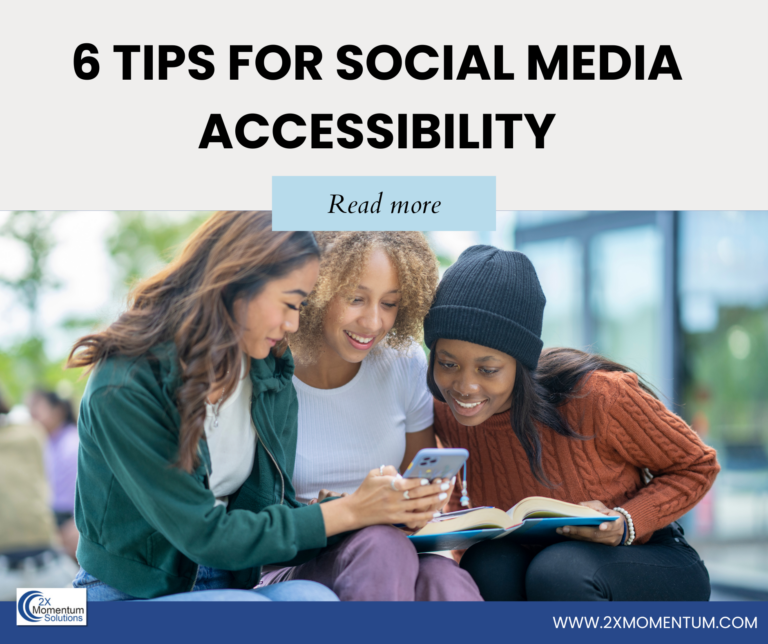Accessibility often gets overlooked; sometimes, we don’t realize we’re not up to standard until someone points it out!
To avoid this situation, it’s important to proactively consider accessibility basics. While every aspect of your business should be accessible, one area where you can make immediate improvements is social media. Let’s dive into what accessibility means, why it’s important, and how you can integrate it into your social media plan!

What is Accessibility?
According to the U.S. Department of Education’s Office for Civil Rights, “Accessible means a person with a disability is afforded the opportunity to acquire the same information, engage in the same interactions, and enjoy the same services as a person without a disability in an equally effective and equally integrated manner, with substantially equivalent ease of use.”
When it comes to social media in particular, this means making sure that people with disabilities or impairments—including visual, auditory, cognitive, and neurological—can understand and interact with your content.
Why is Accessibility Important?
Accessibility helps those with disabilities have equal access to information and services. It can also improve the user experience for everyone else.
Accessibility is also essential from a business point of view. By following the requirements for web accessibility from the Americans with Disabilities Act (ADA), businesses are able to expand their reach, keep a positive brand reputation, and stay in legal compliance. When it comes to social media, accessibility can help your social media metrics improve. And, of course, it’s just the right thing to do!
How Can You Make Your Social Media Accessible?
If you’re ready to improve the accessibility of your social media accounts, we have some tips to help:
Tip 1: Provide alt text.
Alternative text (alt text) describes images—including photos, infographics, or charts—for people who use screen readers. Your alt text should clearly and concisely describe the image and any text it contains. This helps people with visual impairments understand the complete post.
Tip 2: Use emojis and hashtags judiciously.
Emojis and hashtags absolutely have their place in social media! But too many of either can be distracting for people using screen readers, as each one will be read out. Limit your emoji and hashtag use, and try to keep emojis at the end of paragraphs and hashtags at the end of the post. Capitalize each word of your hashtags so that screen readers can accurately read them.
Tip 3: Choose colors carefully.
When you have text on a colorful background, aim for high contrast to make it easier to see. Darker text on a lighter background is usually better than the opposite. This benefits users with visual impairments or color blindness.
Tip 4: Select easy-to-read fonts.
Your Facebook or Instagram post copy will use the platforms’ default fonts, but don’t forget about fonts for graphics and infographics! Any text you include should use a simple, clear font so that it’s easier for people to read.
Tip 5: Use plain language.
Write using clear, simple language that most people can understand easily, avoiding jargon or excessively complicated words. Spell out acronyms the first time you use them. This can help anyone who may struggle with reading, including people who are learning English as a second (or third!) language.
Tip 6: Caption videos.
Short-form video is a popular content marketing trend. You can make videos accessible by including captions of any words spoken during the video. You can also include audio descriptions, which are recorded audio clips that describe what’s happening in the video.
Need Help with Accessibility?
If you’re looking for help with accessibility or any other part of your social media strategy, 2XM is here! Our marketing programs are tailor-made to suit your needs and budget. Contact us for a FREE 60 minute consultation today.
